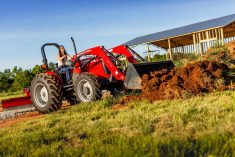In south-central Manitoba, a man we’ll call Ronnie, 57, lives on a 640-acre farm he inherited from his late parents. He’s never farmed and has no interest in swapping careers from the office work he did before retiring a few years ago. His plan is to sell the farm within three years and build a new house with a $700,000 price tag to replace the house, which is worth $250,000, on the property. The $250,000 can go to investments, such as a Tax-Free Savings Account (TFSA) or into an ordinary taxable account. That will lower the net price of the new house to $450,000.
Ronnie approached Colin Sabourin, a certified financial planner and farm transition specialist at Winnipeg Financial Planning.
Moving from the farm to town and selling the farm he inherited created several opportunities to make money and to save tax, Sabourin notes.
Read Also

Gentle treatments for pain in the neck
Heading toward year-end, people unknowingly tense up against the cold and busyness, causing neck pain that can often be treated with appropriate support and gentle mobility, athletic therapist Kathlyn Hossack says.
The farm, with an estimated present value of $2,880,000, has an adjusted cost base of $1,630,000 and, thus, a taxable gain of $1,250,000. The sale would create a big tax bill, but Ronnie can use his $1,000,000 lifetime capital gains exemption. It’s qualified farm property, after all.
At present, Ronnie’s farmland, $2,880,000, house, $250,000, $350,000 in a Registered Retirement Savings Plan (RRSP) and a TFSA of $60,000 add up to $3,540,000. He is a moderately wealthy man cast into the role of owning a farm he would rather not keep. It is moderately profitable, however. He needs to do tax planning. That means saving his best ongoing shelter after the lifetime capital gains exemption, the RRSP, for when his income rises.
The farm has current rental income of $57,600 and net income of $46,080. He is in a 27.75 per cent tax bracket. Ronnie’s contributions of $5,000 per year save only $1,377. Save the RRSP contribution room for the year Ronnie sells and jumps into a higher bracket, Sabourin advises.
If the farmland does not appreciate in the next three years, Ronnie will have a $1.25 million capital gain from the sale of the farm. The lifetime exemption will cut that to $250,000. He will be in a 50 per cent tax bracket and thus have to add $125,000 to his taxable income.
By saving his available RRSP room, Ronnie will be able to reduce his taxable income from $125,000 to $55,000. That will generate tax savings of $27,180. That’s 39 per cent of the $70,000 RRSP contribution.
Ronnie’s current taxable income is $46,080. If he wants to sell, it is best to wait until early 2022, so that he does not add the $125,000 of taxable income he will generate by the sale on top of the $46,080 net income he has at present.
If Ronnie then waits an additional year to start Canada Pension Plan (CPP) benefits, he will add 7.2 per cent for each year after 60 he delays the start — it’s the converse of paying a penalty of 7.2 per cent per year for every year before 65 that he starts benefits.
There is a timeline for harvesting income and benefits, Sabourin notes: 2024 is rental income of $46,080 and 2025 is to sell the farmland and take $125,000 taxable income. Sell the existing house for 2026 and start CPP.
The old saying that there is no such thing as a free lunch applies to tax planning where, with great care, one can have an almost-free lunch.
In the year that Ronnie declares his capital gain sheltered by the lifetime exemption, 2025 in this case, he will have total income of $625,000. His taxable income will be just $125,000. The Alternative Minimum Tax (AMT) will raise tax payable to $70,000 for 2026. The AMT carries forward and allows application of this surtax to be deducted from taxes due in each of the following seven years.
There is a hook in the carry forward, however. As Sabourin notes, if Ronnie does not generate a total of $70,000 of tax due in the seven year period or dies before the carry forward credit is used up, the unused balance will be lost.
To make sure the AMT carry- forward is used up, Ronnie should make sure his tax bill pre-AMT credit is at least $10,000. That means he needs about $50,000 of taxable income each year. His CPP benefit payments will be $12,000 per year, so he will have to generate $50,000 minus $12,000, or $38,000 of taxable income. Any combination of RRSP withdrawals, capital gains interest or even employment income should he have a part-time job will do the trick.
After Ronnie sells his farmland, he would like to build his dream home, a $700,000 house. Take off the $70,000 RRSP contribution and $700,000 for the new house and he will be left with $2,023,000. Before that, he can maximize contributions to his TFSA with the balance left in a non-registered account. In the new house, living expenses may rise to $50,000 per year, Ronnie estimates.
Spending $700,000 or $450,000 net for a new house should not cause financial distress, Sabourin explains. Even if Ronnie stresses his budget, the likely appreciation of the new house should allow dips into capital to sustain spending.














